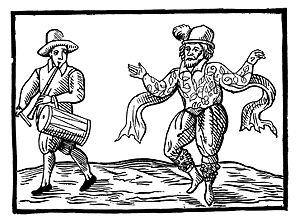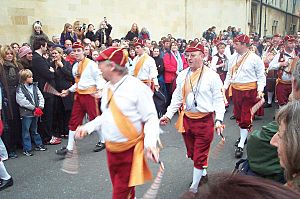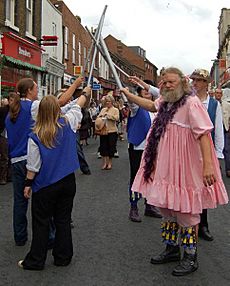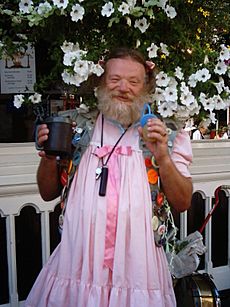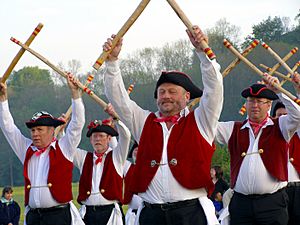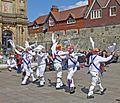Morris dance facts for kids
Morris dancing is a fun and lively type of English folk dance. It involves dancers moving rhythmically and performing special patterns together. Dancers often wear bell pads on their shins, which jingle as they move! They might also use things like sticks, swords, or handkerchiefs in their dances. Sometimes, for dances with one or two people, they dance over clay tobacco pipes laid on the floor.
The first time Morris dancing was written about in England was in 1448. Records show the Goldsmiths' Company in London paid Morris dancers. Later, in the late 1500s, more records appeared, mentioning sword dancing and other dance activities.
At first, Morris dancing was mainly seen in royal courts and big city parades. But by the mid-1600s, it became a popular folk dance performed in villages and towns.
Today, three main groups help organize and support Morris dancing in England: the Morris Ring, the Morris Federation, and Open Morris. All these groups also have members from other countries. There are about 150 Morris dance teams (called "sides") in the United States. Many English people living in Australia, Canada, New Zealand, and Hong Kong also keep the Morris tradition alive. You can even find groups in places like the Netherlands, Finland, Sweden, Cyprus, and Russia!
Contents
What's in a Name?
The name "Morris" seems to come from the word "morisco," which means "Moorish" (referring to people from North Africa). Some people think the name came from dancers blackening their faces as part of their costumes.
The term "Moorish dance" first appeared in English in the mid-1400s. Similar names for this type of dance exist in other languages, like German, French, Italian, and Spanish. The modern spelling "Morris-dance" started in the 1600s.
It's not totally clear why the dance was called "Moorish." It might have been because of the dancers' exciting movements or their "exotic" costumes. The English dance likely became popular as part of a wider trend in Europe during the 1400s for "Moorish" performances.
Traditionally, some dancers used face paint. In recent years, many groups have changed to using blue, green, or striped face paint instead of black. This change happened in response to modern discussions about cultural sensitivity.
A Look Back at History
The earliest records from the 1400s show Morris dancing in fancy court settings. By the late 1500s, it became a dance for everyone. King Henry VIII even owned a gold salt shaker that showed a Morris dance with five dancers and a small drum called a "tabret." In 1600, a famous actor named William Kempe Morris danced all the way from London to Norwich!
By the mid-1600s, everyday people were doing Morris dances, especially during spring festivals like Whitsun. However, the Puritan government, led by Oliver Cromwell, stopped these festivals. When the king, Charles II, came back to power, the spring celebrations returned.
Morris dancing stayed popular until the industrial revolution changed society a lot. Four teams say they have danced continuously in their villages for a very long time: Abingdon, Bampton, Headington Quarry, and Chipping Campden. Many other villages have brought back their old traditions, and hundreds of teams worldwide have learned and adapted these dances or even created their own.
The Morris Revival
The modern revival of Morris dancing is often said to have started on December 26, 1899. A man named Cecil Sharp was visiting a friend in Headington, near Oxford, when the Headington Quarry Morris side came to perform. Sharp was fascinated by their music and wrote down many of their tunes. About ten years later, he started writing down the dances themselves. He was helped by Mary Neal, who ran a club for young working women in London. The first modern Morris performance was actually by these young women in London!
Morris Groups Today
In the early 1900s, several men's Morris sides were formed. In 1934, the Morris Ring was created by six of these groups. Later, in the 1950s and 1960s, many new dance teams started, including groups with women or mixed genders. At first, there was some debate about women dancing Morris, even though there's old evidence that women did dance it in the 1500s. Now, you can find male, female, and mixed Morris sides everywhere.
Because women's and mixed sides couldn't be full members of the Morris Ring at first (this has since changed), two other national groups were formed: the Morris Federation and Open Morris. All three groups help their members with communication, advice, and dancing opportunities. They also work together on some issues.
Morris Dancing in Wales
In the 1960s, there was a big comeback for folk dancing and Morris dancing in the United Kingdom. In Wales, this meant more interest in the Nantgarw tradition. Teams wanted to add Welsh dances to their English ones. The Cardiff Morris Men started putting together a Morris dance from notes written by Ceinwen Thomas about a dance called Y Gaseg Eira. After this "original" dance was put back together, teams started creating more dances "in the style of" the Nantgarw Morris dance. Many of these new dances, like Y Derwydd, are now considered part of the Nantgarw tradition.
Today, five Morris dances are commonly known as part of the Nantgarw tradition: Y Gaseg Eira (The Snow Mare), Hela'r Sgwarnog (Hunting the Hare), Ty Coch Caerdydd (Red House of Cardiff), Y Derwydd (The Druid), and Y Goron (The Crown).
It's interesting to note that the Welsh Nantgarw style of Morris dance is similar to the English Lichfield style. This might be because pottery workers from Staffordshire, where Lichfield Morris was danced, moved to work in the potteries in Nantgarw.
Nantgarw Dances
Y Gaseg Eira (The Snow Mare)
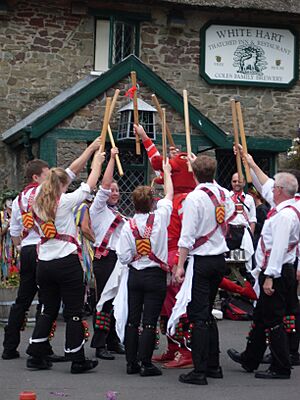
This dance uses handkerchiefs and has a unique pattern. It was the first Nantgarw dance that the Cardiff Morris team brought back. The name means "snowball" in Welsh, because at one point, the hand movements look like someone rolling a big snowball. This dance was being performed by Cardiff Morris by 1974.
Hela'r Sgwarnog (Hunting the Hare)
This is a handkerchief dance that follows a standard pattern, making it easy to remember. It's often danced to hornpipe music, which gives it a bouncy feel. This dance was added to the Nantgarw collection by 1984.
Ty Coch Caerdydd (The Red House of Cardiff)
This dance uses sixteen sticks! Dancers hold the sticks like ski poles and clash them together in front of their faces. It was also being danced by 1984.
Y Derwydd (The Druid)
This dance uses only eight sticks and has no clashing except in the chorus. The dance pattern is similar to "Hunting the Hare," but with different "Stars" figures in the corners. It was created in 1991.
Y Goron (The Crown)
This is a stick dance that involves circular movements.
Nos Galan (New Year's Eve)
This is a processional dance, meaning dancers move from one place to another. It's named after an old Welsh carol, whose tune is used for the famous song "Deck the Halls".
Dance Moves
Figures
The main dance moves, called "figures," include Foot Up, Corners Change, Top Hey, Bottom Hey, and Circular Hey. Each dance also usually has a special "verse figure" that makes it unique.
Steps
Dancers mostly use a "double step," except when "chipping" (hopping in one spot while turning). The basic pattern is two double steps followed by four "capers" (jumps). Hand movements are usually straight up and down, with circular movements at the waist during capers. In the "chipping" parts of some dances, arms are raised one at a time with each step.
Different Styles of Morris
Today, there are six main styles of Morris dancing. Within each style, there are different "traditions" named after the area they came from.
- Cotswold Morris: Dances from an area mostly in Gloucestershire and Oxfordshire. Dancers usually use handkerchiefs or sticks with their hand movements. These dances are typically for 6 or 8 dancers, but sometimes for one or two (called "jigs").
- North West Morris: This style is more like a military march and is often done in parades. It developed in the mills of North-West England in the 1800s and early 1900s.
- Border Morris: From the English-Welsh border, this style is simpler, looser, and more energetic. Dancers sometimes have blackened or colored faces.
- Long Sword dance: From Yorkshire and Teesdale, this dance uses long, stiff metal or wooden "swords." Usually, six or eight dancers perform it.
- Rapper sword: From Northumberland and County Durham, this dance uses short, flexible steel "swords." Usually, five dancers perform it.
- Molly dance: From Cambridgeshire, traditionally danced on Plough Monday. These were dances done to collect money during hard winters. One dancer would dress as a woman, which is where the name comes from.
Cotswold Style

Many towns and villages have their own Cotswold Morris traditions, like Abingdon, Bampton, and Chipping Campden. Each tradition has its own unique steps, arm movements, and dance figures.
North West Style
The North West style is named after the North West region of England. Historically, this style has always included mixed-gender and female dance teams, going back to the 1700s. Dancers often wore shoes or boots, but dancing in clogs was also common. Many modern groups now wear clogs.
These dances were often part of local festivals or holidays. Some teams still practice only for these events, but most now practice all year, performing mostly in spring and summer. The dances often involved complex weaving movements. Some dancers used a wicker hoop decorated with flowers, held above their heads.
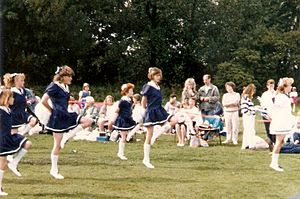
The Britannia Coconut Dancers, from near Bacup, are unique. They use sawn bobbins (wooden spools) to make noise and dance to brass band music. They are one of the few North West Morris groups that still blacken their faces. It's said their dance came from Cornish miners who moved to work in the Rossendale quarries.
Carnival Morris dancing is similar to North West Morris but has developed differently since the 1940s. It's very popular, with thousands of dancers today. Girls' carnival Morris dancing is very competitive, with precise, synchronized routines using pom-poms (or "shakers") danced to pop music. It's mostly performed by girls and women in Lancashire, Cheshire, and parts of North Wales. These performances are usually in sports halls and community centers.
Border Style
The name "Border Morris" was first used in 1963 for Morris dance traditions from counties along the border with Wales, like Herefordshire, Shropshire, and Worcestershire. In the 1800s and early 1900s, Border Morris dancers often used black or colored face paint. They might wear a small strip of bells or no bells at all. Their costumes were often regular clothes decorated with ribbons, cloth strips, or colored paper. They usually had only a few traditional dances in their repertoire, focusing mostly on stick dances.
Sword Dancing
Sword dancing is often seen as a type of Morris, but many performers consider it its own traditional dance. It includes both rapper sword and longsword traditions. In both styles, the "swords" are not real weapons but special tools made for the dance. Dancers are usually linked together by the swords.
Rapper sword teams have five dancers who stay linked during the dance. The rapper sword is a very flexible strip of spring-steel with a wooden handle at each end. Longsword teams usually have five to eight dancers. The longsword is about 0.8 meters (2 feet 6 inches) long, with a wooden handle and a blunt tip. Sometimes ribbons are tied to the sword tips. Both rapper and longsword dances often include a special "character" who dances around the main group.
Other Traditions
Other forms of Morris include Molly dance from Cambridgeshire. Molly dance is linked to Plough Monday and is a playful style danced in work boots. At least one "Molly man" dresses as a woman. The biggest Molly Dance event is the Whittlesea Straw Bear Festival in Cambridgeshire every January.
There's also Stave dancing from the south-west of England and the famous Abbots Bromley Horn Dance.
Another Morris tradition is Vessel Cupping, which was practiced in the East Riding of Yorkshire until the 1920s. This was danced by traveling ploughboys in groups of three or four around the time of Candlemas.
Music for Morris Dancing
Music for Morris dancing was traditionally played on a pipe and tabor (a small drum and flute) or a fiddle. These instruments are still used, but the most common instrument today is the melodeon. Accordions and concertinas are also popular, and sometimes other instruments are used, often with drums.
Cotswold and sword dancers usually have one musician, but North West and Border sides often have a whole band, usually including a drum.
For Cotswold and Border dances, the tunes are traditional and specific to each dance. The dance name is often the tune name. For North West and sword dancing, there isn't always a specific tune for a dance; musicians might use several tunes and even change them during a dance.
Many dances with set tunes also have a short song that goes with the tune. This is sung by the musician or the whole team before the dance starts.
Morris Words and Phrases
Like many activities, Morris dancing has its own special words:
- The Morris: This term refers to the whole world of Morris dancing.
- Side or Team: A group of Morris dancers is called a "side" or a "team." These words mean the same thing.
- Set: This is a group of dancers arranged in a certain way for a dance. Most Cotswold Morris dances are done in a rectangular set of six dancers, and most North West dances in a set of eight.
- Jig: A dance performed by one or sometimes two dancers, not a whole set.
- Squire: The leader of a Morris side. They might speak for the group, lead the dances, or manage the team's schedule.
- Foreman: This person teaches and trains the dancers. They make sure the dancing style and quality are good.
- Bagman: Traditionally, the person who looks after the team's money and equipment. Today, they might also handle bookings and act as a secretary.
- Ragman: On some teams, this person manages the team's costumes, including making bell-pads and sashes.
- Fool: Many sides have one or more "fools." A fool usually wears a wild costume and talks directly to the audience. They often dance around the main group, adding fun without being part of the main dance.
- Beast: A dancer in a costume that looks like an animal, real or mythical. Beasts mostly interact with the audience, especially children. This dancer is sometimes called the "hobby."
- Tradition: In Cotswold Morris, a "tradition" is a group of dances from a specific area that share similar steps, arm movements, and dance figures.
- Figures: These are the common dance moves that are part of many dances in a tradition.
- Distinctive Figure (or Chorus): This is the special part of a dance that makes it different from others in the same tradition.
- Ale: In England, an "ale" is a private party where different Morris sides gather to dance for fun. Food is usually provided. Sometimes, an evening ale is part of a longer dancing event where sides perform in public. In North America, "ale" often means a whole weekend of dancing.
The Future of Morris
Morris dancing continues to thrive thanks to many enthusiastic groups. Some teams want to keep the music and dances exactly as they were recorded in the 1800s. Others like to try new things, reinterpreting the music and dances to fit their skills and modern influences.
Age and Gender
In 2009, some people worried that Morris dancing might disappear because not enough young people were joining. However, a survey in 2020 showed that the number of Morris dancers in the UK actually increased from 2014 to 2020! The average age of a Morris dancer in the UK was 55 in 2020. The survey also found that there's now an even balance between male and female performers.
The Internet's Role
The internet has given Morris sides a new way to share their dancing. Many teams now have fun websites that show off their group's personality and list upcoming performances.
Traditionally, Morris sides collected money from spectators in cash. But now, with more people using cards, many sides use portable card payment machines. There are also many Morris-related blogs and online forums, and teams are active on social media.
What Dancers Wear
Morris dancers wear a wide variety of costumes. Cotswold sides often wear mostly white, while Border teams might wear ragged jackets. Some common items of clothing include:
- Bellpads (with bells on them)
- Baldrics (sashes worn across the chest)
- Rosettes
- Sashes
- Waistcoats
- Tatter-coats (or "raggies," jackets with strips of cloth)
- Knee-length breeches (pants)
- Wooden clogs
- Straw hats, top hats, or bowler hats
- Neckerchiefs
- Armbands
Other Fun Facts
- The board games three men's morris and nine men's morris might be named after the dance.
- A German sculptor named Erasmus Grasser created 16 amazing wooden statues in the late 1400s called the Morris dancers.
- Two ships in the Royal Navy in the 1900s were named Morris Dance.
See also
 In Spanish: Danza Morris para niños
In Spanish: Danza Morris para niños
- Blackface and Morris dancing
- Country dance
- Moresca
- Pipe and tabor
- Saint George's Day in England
- Way of the Morris, a 2011 documentary film
- Weapon Dance
Images for kids
-
Morris dancers with handkerchiefs in York



